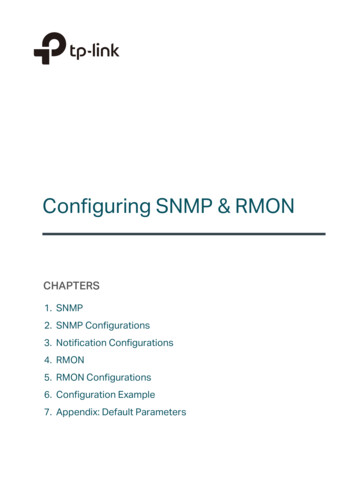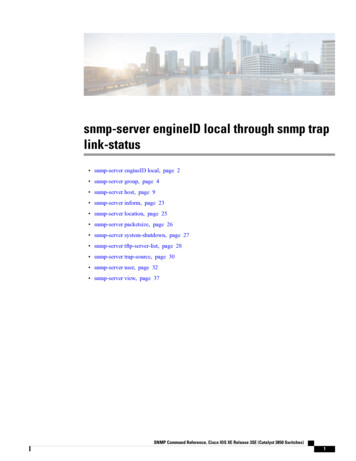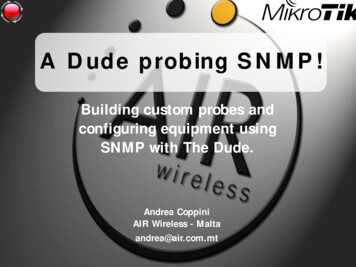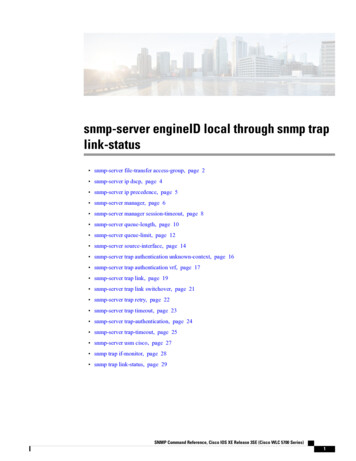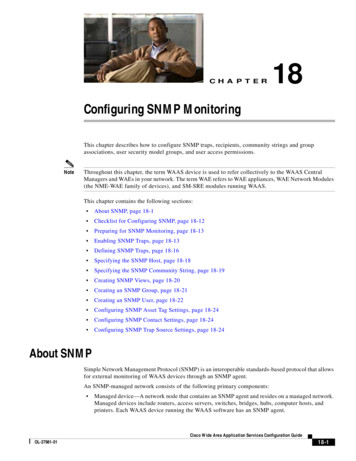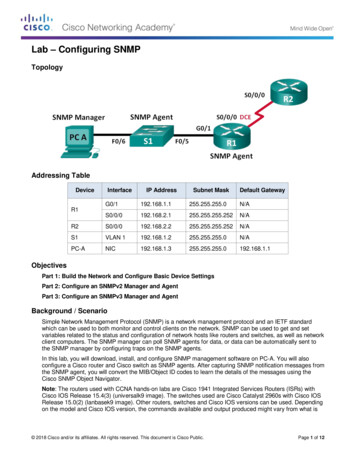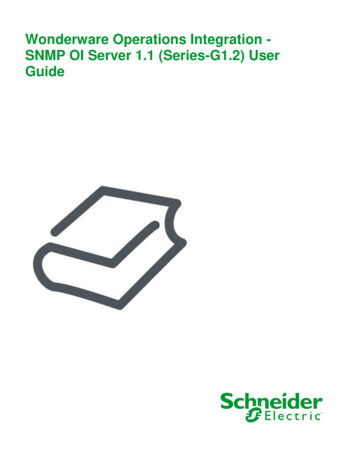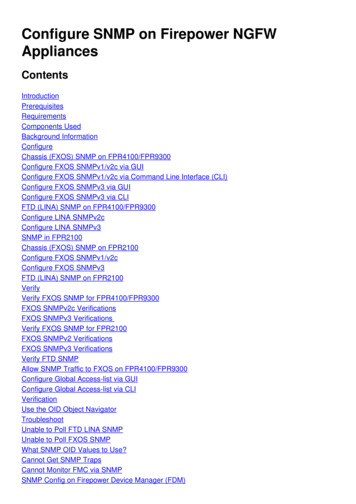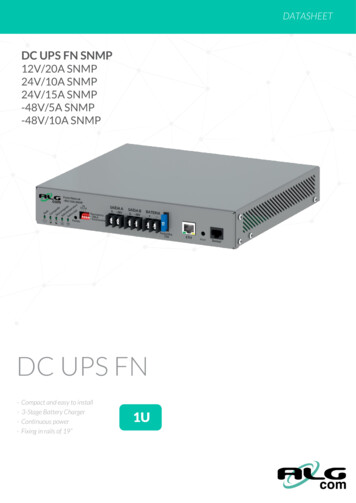
Transcription
Configuring SNMP and using the NetFlow MIBto Monitor NetFlow DataLast Updated: November 27, 2012NetFlow is a technology that provides highly granular per-flow statistics on traffic in a Cisco router. TheNetFlow MIB feature provides MIB objects to allow users to configure NetFlow and to monitor flow cacheinformation, the current NetFlow configuration, and statistics. Finding Feature Information, page 1Prerequisites for Configuring SNMP and the NetFlow MIB to Monitor NetFlow Data, page 1Restrictions for Configuring SNMP and the NetFlow MIB to Monitor NetFlow Data, page 2Information About Configuring SNMP and the NetFlow MIB to Monitor NetFlow Data, page 2How to Configure SNMP and use the NetFlow MIB to Monitor NetFlow Data, page 4Configuration Examples using SNMP and the NetFlow MIB to Monitor NetFlow Data, page 18Additional References, page 20Feature Information for Configuring SNMP and using the NetFlow MIB to Monitor NetFlow Data,page 22Glossary, page 22Finding Feature InformationYour software release may not support all the features documented in this module. For the latest caveatsand feature information, see Bug Search Tool and the release notes for your platform and software release.To find information about the features documented in this module, and to see a list of the releases in whicheach feature is supported, see the feature information table at the end of this module.Use Cisco Feature Navigator to find information about platform support and Cisco software image support.To access Cisco Feature Navigator, go to www.cisco.com/go/cfn. An account on Cisco.com is not required.Prerequisites for Configuring SNMP and the NetFlow MIB toMonitor NetFlow DataBefore you enable NetFlow you must:Americas Headquarters:Cisco Systems, Inc., 170 West Tasman Drive, San Jose, CA 95134-1706 USA
NetFlow MIB Feature BenefitsRestrictions for Configuring SNMP and the NetFlow MIB to Monitor NetFlow Data Configure the router for IP routingEnsure that one of the following is enabled on your router, and on the interfaces that you want toconfigure NetFlow on: Cisco Express Forwarding (CEF), distributed CEF, or fast switchingUnderstand the resources required on your router because NetFlow consumes additional memory andCPU resourcesConfigure SNMP on the router on which the NetFlow MIB feature is to be used. Refer to theConfiguring the Router to use SNMP, page 5 for more information. For more information onconfiguring an SNMP server, refer to the Configuring SNMP Support in the Cisco IOS NetworkManagement Configuration Guide .Restrictions for Configuring SNMP and the NetFlow MIB toMonitor NetFlow DataCisco IOS Releases 12.2(14)S, 12.0(22)S, or 12.2(15)TIf your router is running a version of Cisco IOS prior to releases 12.2(14)S, 12.0(22)S, or 12.2(15)T the iproute-cache flow command is used to enable NetFlow on an interface.If your router is running Cisco IOS release 12.2(14)S, 12.0(22)S, 12.2(15)T, or later the ip flow ingresscommand is used to enable NetFlow on an interface.Information About Configuring SNMP and the NetFlow MIB toMonitor NetFlow Data NetFlow MIB Feature Benefits, page 2NetFlow MIB Overview, page 3Using SNMP and MIBs to Extract NetFlow Information, page 4Objects That are Used by the NetFlow MIB, page 4NetFlow MIB Feature BenefitsNetFlow is a technology that collects traffic flow statistics on routing devices. NetFlow has been used for avariety of applications, including traffic engineering, usage-based billing, and denial of service (DoS)attack monitoring.The NetFlow MIB feature is useful for obtaining IP flow information from a Cisco router when a NetFlowexport operation is not possible. NetFlow exporting does not have to be enabled for the NetFlow MIBfeature to be used. The NetFlow MIB feature can be implemented instantaneously at any point in thenetwork to obtain flow information.With the NetFlow MIB feature, system information that is stored in the flow cache can be accessed in realtime by utilizing a MIB implementation based on SNMP. This information is accessed using get and setcommands entered on the network management system (NMS) workstation for which SNMP has beenimplemented. The NMS workstation is also known as the SNMP manager.2
NetFlow MIB OverviewTerminology UsedNetFlow MIB OverviewThe Netflow MIB provides a simple and easy method to configure NetFlow, NetFlow aggregation caches,and NetFlow Data Export. You use the snmpget and snmpwalk tools to get NetFlow cache information andcurrent NetFlow configuration information. The NetFlow MIB feature enables medium to small sizeenterprises to take advantage of NetFlow technology over SNMP at a reduced infrastructure cost. The MIBis created to provide Netflow information in these areas: Cache information and configuration.Export information and configuration.Export Statistics.Protocol Statistics.Version 9 Export Template information.Top Flows information.Terminology Used, page 3Terminology UsedFlowA flow is defined as an unidirectional sequence of packets between a given source and destinationendpoints. Network flows are highly granular; flow endpoints are identified both by IP address as well asby transport layer application port numbers. NetFlow also utilizes the IP Protocol type, Type of Service(ToS) and the input interface identifier to uniquely identify flows.ExporterA device (for example, a router) with NetFlow services enabled. The exporter monitors packets entering anobservation point and creates flows out of these packets. The information from these flows are exported inthe form of Flow Records to the collector. You can configure NetFlow data export using the NetFlow MIB.Flow RecordA Flow Record provides information about an IP Flow that exists on the Exporter. The Flow Records arecommonly referred to as NetFlow Services data or NetFlow data.CollectorThe NetFlow Collector receives Flow Records from one or more Exporters. It processes the received exportpacket, i.e. parses, stores the Flow Record information. The flow records may be optionally aggregatedbefore storing into the hard disk.TemplateNetFlow Version 9 Export format is template based. Version 9 record format consists of a packet headerfollowed by at least one or more template or data FlowSets. A template FlowSet (collection of one or moretemplate) provides a description of the fields that will be present in future data FlowSets. Templatesprovide an extensible design to the record format, a feature that should allow future enhancements toNetFlow services without requiring concurrent changes to the basic flow-record format.3
Using SNMP and MIBs to Extract NetFlow InformationHow to Configure SNMP and use the NetFlow MIB to Monitor NetFlow DataOne additional record type is also a part of Version 9 specification: an options template. Rather thansupplying information about IP flows, options are used to supply meta-data about the NetFlow processitself.Top FlowsThis feature provides a mechanism which allows the top N flows in the NetFlow cache to be viewed in realtime.Criteria can be set to limit the feature to particular flows of interest, which can aid in DoS detection.Only the number of flows (TopN) and the sort criteria (SortBy) need be set.Top Flows is not intended as a mechanism for exporting the entire netflow cache.For more information on the Top Flows and the NetFlow MIB refer to the Configuring NetFlow TopTalkers using Cisco IOS CLI Commands or SNMP Commands.Egress flowsThis feature analyzes traffic that is being forwarded by the router. This feature is often referred to as EgressNetFlow.Using SNMP and MIBs to Extract NetFlow InformationSNMP has historically been used to collect network information. SNMP permits retrieval of criticalinformation from network elements such as routers, switches, and workstations. The NetFlow MIB featureuses SNMP to configure NetFlow and to gather NetFlow statistics.The NetFlow MIB feature allows NetFlow statistics and other NetFlow data for the managed devices onyour system to be retrieved by SNMP. You can specify retrieval of NetFlow information from a manageddevice (for example, a router) either by entering commands on that managed device or by entering SNMPcommands from the NMS workstation to configure the router via the MIB. If the NetFlow information isconfigured from the NMS workstation, no access to the router is required and all configuration can beperformed via SNMP. The NetFlow MIB request for information is sent from an NMS workstation viaSNMP to the router and is retrieved from the router. This information can then be stored or viewed, thusallowing NetFlow information to be easily accessed and transported across a multi-vendor programmingenvironment.Objects That are Used by the NetFlow MIBThe NetFlow MIB feature defines managed objects that enable a network administrator to remotelymonitor the following NetFlow information: Flow cache configuration informationNetFlow export informationGeneral NetFlow statisticsHow to Configure SNMP and use the NetFlow MIB to MonitorNetFlow Data4
Configuring the Router to use SNMPHow to Configure SNMP and use the NetFlow MIB to Monitor NetFlow DataNoteSome of the tasks in this section include examples of the SNMP CLI syntax used to set configurationparameters on the router, and to read values from MIB objects on the router. These SNMP CLI syntaxexamples are taken from a Linux workstation using public domain SNMP tools. The SNMP CLI syntax foryour workstation might be different. Refer to the documentation that was provided with your SNMP toolsfor the correct syntax for your network management workstation. Configuring the Router to use SNMP, page 5Configuring Options for the Main Cache, page 6Configuring Options for the Main Cache, page 8Identifying the Interface Number to use for Enabling NetFlow with SNMP, page 9Configuring NetFlow on an Interface, page 9Configuring NetFlow on an Interface, page 11Configuring the Destination-Prefix Aggregation Cache, page 11Configuring the Destination-Prefix Aggregation Cache, page 13Configuring NetFlow Export from the Main NetFlow Cache using the Version 9 Export Format,page 15Configuring NetFlow Export from the Main NetFlow Cache using the Version 9 Export Format,page 17Configuring the Router to use SNMPBefore the NetFlow MIB feature can be used, the router must be configured to support SNMP. To enableSNMP on the router, perform this task.NoteThe SNMP community read-only (RO) string for the examples is public. The SNMP community read-write(RW) string for the examples is private. You should use more complex strings for these values in yourconfigurations.SUMMARY STEPS1. enable2. configure terminal3. snmp-server community string ro4. snmp-server community string rw5. end5
Configuring Options for the Main CacheHow to Configure SNMP and use the NetFlow MIB to Monitor NetFlow DataDETAILED STEPSCommand or ActionStep 1 enablePurpose(Required) Enables privileged EXEC mode. Enter your password if prompted.Example:Router enableStep 2 configure terminal(Required) Enters global configuration mode.Example:Router# configure terminalStep 3 snmp-server community string ro(Required) Sets up the community access string to permit access to SNMP. Example:Router(config)# snmp-servercommunity public roStep 4 snmp-server community string rw (Required) Sets up the community access string to permit access to SNMP. Example:Router(config)# snmp-servercommunity private rwThe string argument is a community string that consists of from 1 to 32alphanumeric characters and functions much like a password, permittingaccess to the SNMP protocol. Blank spaces are not permitted in thecommunity string.The ro keyword specifies read-only access. SNMP management stationsusing this string can retrieve MIB objects. The string argument is a community string that consists of from 1 to 32alphanumeric characters and functions much like a password, permittingaccess to the SNMP protocol. Blank spaces are not permitted in thecommunity string.The rw keyword specifies read-write access. SNMP management stationsusing this string can retrieve and modify MIB objects.Note The string argument must be different from the read-only string argumentspecified in the preceding step (Step 3).Step 5 end(Required) Exits the current configuration mode and returns to privileged EXECmode.Example:Router(config)# endConfiguring Options for the Main CacheThis optional task describes the procedure for modifying the parameters for the NetFlow main cache.Perform the steps in this optional task using either the router CLI commands or the SNMP commands tomodify the parameters for the NetFlow main cache.6
Configuring Options for the Main CacheHow to Configure SNMP and use the NetFlow MIB to Monitor NetFlow DataSUMMARY STEPS1. enable2. configure terminal3. ip flow-cache entries number4. ip flow-cache timeout active minutes5. ip flow-cache timeout inactive seconds6. endDETAILED STEPSCommand or ActionStep 1 enablePurpose(Required) Enables privileged EXEC mode. Enter your password if prompted.Example:Router enableStep 2 configure terminal(Required) Enters global configuration mode.Example:Router# configure terminalStep 3 ip flow-cache entries numberExample:(Optional) Specifies the maximum number of entries to be captured for themain flow cache.Note The valid range for the number argument is from 1024 to 524288entries.Router(config)# ip flow-cacheentries 4000Step 4 ip flow-cache timeout active minutesExample:(Optional) Configures operational parameters for the main cache. Router(config)# ip flow-cachetimeout active 30Step 5 ip flow-cache timeout inactive secondsExample:Router(config)# ip flow-cachetimeout inactive 100The timeout keyword dissolves the session in the cache.The active minutes keyword-argument pair is the number of minutesthat an entry is active. The range is from 1 to 60 minutes. The default is30 minutes.(Optional) Configures operational parameters for the main cache. The timeout keyword dissolves the session in the main cache.The inactive secondskeyword-argument pair is the number of secondsthat an inactive entry will stay in the main cache before it times out. Therange is from 10 to 600 seconds. The default is 15 seconds.7
Configuring Options for the Main CacheHow to Configure SNMP and use the NetFlow MIB to Monitor NetFlow DataCommand or ActionStep 6 endPurpose(Required) Exits the current configuration mode and returns to privilegedEXEC mode.Example:Router(config)# endConfiguring Options for the Main CacheSUMMARY STEPS1. snmpset -c private -m all -v2c [ip-address hostname] cnfCICacheEntries.type unsigned number2. snmpset -c private -m all -v2c [ip-address hostname] cnfCIActiveTimeOut.type unsigned number3. snmpset -c private -m all -v2c [ip-address hostname] ccnfCIInactiveTimeOut.type unsignednumberDETAILED STEPSCommand or ActionPurposeStep 1 snmpset -c private -m all -v2c [ip-address (Optional) Defines the maximum number of entries to be captured for thehostname] cnfCICacheEntries.type unsigned main flow cache.number The value for the type argument in cnfCICacheEntries.typeunsigned number is 0 for the main cache. Thevalue for the number argument inExample:cnfCICacheEntries.typenumber is the maximum number of cacheworkstation% snmpset -c private -m allentries.-v2c 10.4.9.62 cnfCICacheEntries.0unsigned 4000Note The valid range for the number argument is from 1024 to 524288entries.Step 2 snmpset -c private -m all -v2c [ip-address hostname] cnfCIActiveTimeOut.typeunsigned numberExample:workstation% snmpset -c private -m all-v2c 10.4.9.62 cnfCIActiveTimeOut.0unsigned 60(Optional) Specifies the number of seconds that an active flow remains inthe main cache before it times out. The value for the type argument in cnfCIActiveTimeout.typeunsigned number is 0 for the main cache.The value for the number argument in cnfCIActiveTimeout.typeunsigned number is the number of seconds that an active flowremains in the cache before it times out.Note The range for the number argument is from 1 to 60 minutes. Thedefault is 30 minutes.8
Identifying the Interface Number to use for Enabling NetFlow with SNMPHow to Configure SNMP and use the NetFlow MIB to Monitor NetFlow DataCommand or ActionStep 3 snmpset -c private -m all -v2c [ip-address hostname] ccnfCIInactiveTimeOut.typeunsigned numberPurpose(Optional) Specifies the number of seconds that an inactive flow remainsin the main cache before it times out. Example:workstation% snmpset -c private -m all-v2c 10.4.9.62 cnfCIInactiveTimeOut.0unsigned 30The value for the type argument in cnfCIInactiveTimeout.typeunsigned number is 0 for the main cache.The value for the number argument in cnfCIInactiveTimeout.typeunsigned number is the number of seconds that an inactive flowremains in the main cache before it times out.Note The range for the number argument is from 10 to 600 seconds.The default is 15 seconds.Identifying the Interface Number to use for Enabling NetFlow with SNMPBefore you can use SNMP to enable NetFlow on an interface, you must identify the correct SNMPinterface number on the router. To identify the interface number for the interface that you want to enableNetFlow on, perform the steps in this task.SUMMARY STEPS1. enable2. show snmp mib ifmib ifindex type numberDETAILED STEPSStep 1enableEnters privileged EXEC mode. Enter the password if prompted.Example:Router enableStep 2show snmp mib ifmib ifindex type numberDisplays the SNMP interface number for the interface specified.Example:Router# show snmp mib ifmib ifindex fastethernet 0/0Ethernet0/0: Ifindex 1Configuring NetFlow on an InterfacePerform the task using either the router CLI commands or the SNMP commands to enable NetFlow on therouter.9
Configuring NetFlow on an InterfaceHow to Configure SNMP and use the NetFlow MIB to Monitor NetFlow DataSUMMARY STEPS1. enable2. configure terminal3. interface type number4. ip flow {ingress egress}5. exit6. Repeat Steps 3 through 5 to enable NetFlow on other interfaces.7. endDETAILED STEPSCommand or ActionStep 1 enablePurpose(Required) Enables privileged EXEC mode. Enter your password if prompted.Example:Router enableStep 2 configure terminal(Required) Enters global configuration mode.Example:Router# configure terminalStep 3 interface type number(Required) Specifies the interface that you want to enableNetFlow on and enters interface configuration mode.Example:Router(config)# interface fastethernet0/0Step 4 ip flow {ingress egress}(Required) Enables NetFlow on the interface. Example:Router(config-if)# ip flow ingressExample:and/orExample:Router(config-if)# ip flow egress10 ingress --captures traffic that is being received by theinterfaceegress --captures traffic that is being transmitted by theinterface.
Configuring NetFlow on an InterfaceHow to Configure SNMP and use the NetFlow MIB to Monitor NetFlow DataCommand or ActionStep 5 exitPurpose(Optional) Exits interface configuration mode and returns toglobal configuration mode.Note You only need to use this command if you want toExample:enable NetFlow on another interface.Router(config-if)# exitStep 6 Repeat Steps 3 through 5 to enable NetFlow on otherinterfaces.(Optional) --Step 7 end(Required) Exits the current configuration mode and returns toprivileged EXEC mode.Example:Router(config-if)# endConfiguring NetFlow on an InterfaceSUMMARY STEPS1. snmpset -c private -m all -v2c [ip-address hostname] cnfCINetflowEnable.interface-number integer[0 1 2 3]2. Repeat Step 1 to enable NetFlow on other interfacesDETAILED STEPSCommand or ActionStep 1 snmpset -c private -m all -v2c [ip-address hostname]cnfCINetflowEnable.interface-number integer [0 1 2 3]Purpose(Required) Configures NetFlow for an interface.Note The value for the interface-number argument isfound by entering the router CLI commandshow snmp mib ifmib ifindex on the router inprivileged EXEC mode.Example:workstation% snmpset -c private -m all -v2c 10.4.9.62cnfCINetflowEnable.1 integer 1The values for the direction argument are: Step 2 Repeat Step 1 to enable NetFlow on other interfaces0--Disable NetFlow1--Enable Ingress NetFlow2--Enable Egress NetFlow3--Enable Ingress and Egress NetFlow(Optional) --Configuring the Destination-Prefix Aggregation CacheThis task describes the procedure for modifying the parameters for aggregation caches. The destinationprefix is used in this task. With the exception of specifying the aggregation cache that you want to modify,the steps are the same for modifying these parameters for the other aggregation caches.11
Configuring the Destination-Prefix Aggregation CacheHow to Configure SNMP and use the NetFlow MIB to Monitor NetFlow DataPerform this task using either the router CLI commands or the SNMP commands to modify configurationparameters for an aggregation cache.You must enable NetFlow on at least one interface before configuring a NetFlow aggregation cache.SUMMARY STEPS1. enable2. configure terminal3. ip flow-aggregation cache destination-prefix4. cache entries number5. cache timeout active minutes6. cache timeout inactive seconds7. enable8. endDETAILED STEPSCommand or ActionStep 1 enablePurpose(Required) Enables privileged EXEC mode. Enter your password if prompted.Example:Router enableStep 2 configure terminal(Required) Enters global configuration mode.Example:Router# configure terminalStep 3 ip flow-aggregation cache destination-prefixExample:Router(config)# ip flow-aggregationcache destination-prefix(Required) Enters aggregation cache configuration mode for thedestination-prefixaggregation cache. The destination-prefixkeyword is equivalent to the typeargument of 4 in Step 2 of the SNMP commands.Note For information on other keywords for this command, see theCisco IOS NetFlow Command Reference .Step 4 cache entries numberExample:Router(config-flow-cache)# cache entries400012(Optional) Defines the number of entries that are allowed in theaggregation flow cache.
Configuring the Destination-Prefix Aggregation CacheHow to Configure SNMP and use the NetFlow MIB to Monitor NetFlow DataCommand or ActionStep 5 cache timeout active minutesPurpose(Optional) Specifies the number of minutes that an active flow remainsin the cache before it times out.Note The range is from 1 to 60 minutes. The default is 30 minutes.Example:Router(config)# cache timeout active 30Step 6 cache timeout inactive seconds(Optional) Specifies the number of seconds that an inactive flowremains in the cache before it times out.Note The range is from 10 to 600 seconds. The default is 15 seconds.Example:Router(config-flow-cache)# cache timeout inactive 100Step 7 enable(Required) Activates the destination-prefixaggregation cache.Example:Router(config-flow-cache)# enableStep 8 end(Required) Exits the current configuration mode and returns toprivileged EXEC mode.Example:Router(config-if)# endConfiguring the Destination-Prefix Aggregation CacheSUMMARY STEPS1. snmpset -c private -m all -v2c [ip-address hostname] cnfCICacheEnable.type integer truth-value2. snmpset -c private -m all -v2c [ip-address hostname] cnfCICacheEntries. type unsigned number3. snmpset -c private -m all -v2c [ip-address hostname] cnfCIActiveTimeOut. type unsigned number4. snmpset -c private -m all -v2c [ip-address hostname] ccnfCIInactiveTimeOut. type unsignednumber13
Configuring the Destination-Prefix Aggregation CacheHow to Configure SNMP and use the NetFlow MIB to Monitor NetFlow DataDETAILED STEPSCommand or ActionStep 1 snmpset -c private -m all -v2c [ip-address hostname] cnfCICacheEnable.type integertruth-valuePurpose(Required) Enables the aggregation cache. Example:workstation% snmpset -c private -mall -v2c 10.4.9.14 cnfCICacheEnable.4integer 1 Values for the type argument are: Main--0 AS--1 Protocol Port--2 Source Prefix--3 Destination Prefix--4 prefix--5 Destination Only--6 Source Destination--7 Full Flow--8 AS ToS--9 Protocol Port ToS--10 Source Prefix ToS--11 Destination Prefix Tos--12 Prefix Tos--13 Prefix Port--14 BGP Nexthop Tos--15Values for truth-value in cnfCICacheEnable.type integer truthvalueare: Step 2 snmpset -c private -m all -v2c [ip-address hostname] cnfCICacheEntries. typeunsigned numberExample:workstation% snmpset -c private -mall -v2c 10.4.9.62 cnfCICacheEntries.4 unsigned 4000141--enable the aggregation cache2--disable the aggregation cache(Optional) Defines the maximum number of entries to be captured for theaggregation flow cache. The value for the type argument in cnfCICacheEntries.typeunsigned number is 4 for the destination-prefix cache.The value for the number argument in cnfCICacheEntries.typeunsigned number is the maximum number of cache entries.Note The valid range for the number argument is from 1024 to 524288entries.
Configuring NetFlow Export from the Main NetFlow Cache using the Version 9 Export FormatHow to Configure SNMP and use the NetFlow MIB to Monitor NetFlow DataCommand or ActionStep 3 snmpset -c private -m all -v2c [ip-address hostname] cnfCIActiveTimeOut. typeunsigned numberPurpose(Optional) Specifies the number of seconds that an active flow remains inthe cache before it times out. Example:workstation% snmpset -c private -mall -v2c 10.4.9.14 cnfCIActiveTimeOut.4 unsigned 60The value for the type argument in cnfCIActiveTimeout.typeunsigned number is 4 for the destination-prefix cache.The value for the number argument in cnfCIActiveTimeout.typeunsigned number is the number of seconds that an active flowremains in the cache before it times out.Note The range for the number argument is from 1 to 60 minutes. Thedefault is 30 minutes.Step 4 snmpset -c private -m all -v2c [ip-address hostname] ccnfCIInactiveTimeOut. typeunsigned number(Optional) Specifies the number of seconds that an inactive flow remainsin the cache before it times out. Example:workstation% snmpset -c private -mall -v2c 10.4.9.14cnfCIInactiveTimeOut.4 unsigned 30The value for the type argument in cnfCIInactiveTimeout.typeunsigned number is 4 for the destination-prefix cache.The value for the number argument in cnfCIInactiveTimeout.typeunsigned number is the number of seconds that an inactive flowremains in the cache before it times out.Note The range for the number argument is from 10 to 600 seconds. Thedefault is 15 seconds.Configuring NetFlow Export from the Main NetFlow Cache using the Version9 Export FormatThe following example shows how to configure the router to export statistics from the NetFlow main cache(0), including peer autonomous system and BGP-related information using export Version 9.Perform this task using either the router CLI commands or the SNMP commands to configure the router toexport statistics from the main cache using the Version 9.SUMMARY STEPS1. enable2. configure terminal3. ip flow-export version 9 [ origin-as peer-as] [ bgp-nexthop ]4. ip flow-export destination {ip-address hostname} udp-port}5. Repeat Step 4 to add a second NetFlow collector6. end15
Configuring NetFlow Export from the Main NetFlow Cache using the Version 9 Export FormatHow to Configure SNMP and use the NetFlow MIB to Monitor NetFlow DataDETAILED STEPSCommand or ActionStep 1 enablePurpose(Required) Enables privileged EXEC mode. Enter your password if prompted.Example:Router enableStep 2 configure terminal(Required) Enters global configuration mode.Example:Router# configure terminalStep 3 ip flow-export version 9 [ origin-as peer- (Required) Enables the export of information in NetFlow cache entries.as] [ bgp-nexthop ] The version 9 keyword specifies that the export packet uses theVersion 9 format. The origin-as keyword specifies that export statistics include theExample:originating AS for the source and destination.Router(config)# ip flow-export The peer-as keyword specifies that export statistics include the peerversion 9 peer-as bgp-nexthopAS for the source and destination. The bgp-nexthop keyword specifies that export statistics include BGPnext hop-related information.Caution Entering this command on a Cisco 12000 Series Internet Routercauses packet forwarding to stop for a few seconds while NetFlowreloads the route processor and line card CEF tables. To avoidinterruption of service to a live network, apply this commandduring a change window, or include it in the startup-config file tobe executed during a router reboot.Step 4 ip flow-export destination {ip-address hostname} udp-port}(Required) Specifies the IP address, or hostname of the NetFlow collector,and the UDP port the NetFlow collector is listening on.Example:Router(config)# ip flow-exportdestination 10.0.19.2 999Step 5 Repeat Step 4 to add a second NetFlowcollector(Optional) --Step 6 end(Required) Exits the current configuration mode and returns to privilegedEXEC mode.Example:Router(config)# end16
Configuring NetFlow Export from the Main NetFlow Cache using the Version 9 Export FormatHow to Configure SNMP and use the NetFlow MIB to Monitor NetFlow DataConfiguring NetFlow Export from the Main NetFlow Cache using the Version9 Export FormatSUMMARY STEPS1. snmpset -c private -m all -v2c [ip-address hostname] cnfEIExportVersion.type unsigned versioncnfEIPeerAS. type integer truth-value cnfEIBgpNextHop.type integer truth-value2. snmpset -c private -m all -v2c [ip-address hostname] cnfEICollectorStatus. type . address-type . ipversion . ip-address . port integer [4 6]3. Repeat Step 2 to add another collectorDETAILED STEPSCommand or ActionPurposeStep 1 snmpset -c private -m all -v2c [ip-address (Required) Specifies the export format and that the export statisticshostname] cnfEIExportVersion.type unsigned include peer autonomous system and BGP-related information.version cnfEIPeerAS. type integer truth-value The values for the type argument are:cnfEIBgpNextHop.type integer truth-value Main--0 AS--1Example: Protocol Port--2 Source Prefix--3workstation% snmpset -c private -m all v2c 10.4.9.14 cnfEIExportVersion.0 Destination Prefix--4unsigned 9 cnfEIPeerAS.0 integer 1 prefix--5cnfEIBgpNextHop.0 integer 1
NetFlow also utilizes the IP Protocol type, Type of Service (ToS) and the input interface identifier to uniquely identify flows. Exporter A device (for example, a router) with NetFlow services enabled. The exporter monitors packets entering an observation point and creates flows out of these packets. The information from these flows are exported in
